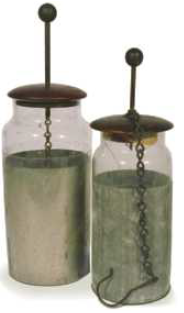Some of the first capacitors constructed were called Leiden jars. These capacitors were actual jars with a
Question:
Some of the first capacitors constructed were called Leiden jars. These capacitors were actual jars with a layer of foil on the inside and outside of the glass as shown in Figure P18.81. A conducting sphere topped a metal rod that in turn connected to a dangling chain that made contact with the inner layer of foil, all held in place by a non-conducting lid made of wood or cork. The Leiden jar was developed in 1745 by Pieter van Musschenbroeck of the University of Leiden, the Netherlands, but Benjamin Franklin?s experiments with these jars led to an understanding of how energy is stored within the jar. The working assumption at the time was that electricity had a fluid nature, so the shape of a jar for storage fit well with this initial hypothesis. One of Franklin?s jars measured 4 in. in diameter, with foil on the bottom and up the sides to a height of 9 in.?
(a) Estimate the approximate capacitance of his Leiden jar if the wall of the jar is 18 in. thick. (Find the area of foil coverage and assume an equivalent parallel-plate capacitor.)?
(b) What is the maximum energy that could be stored in such a device?
Figure P18.81
?
Step by Step Answer:

College Physics Reasoning and Relationships
ISBN: 978-0840058195
2nd edition
Authors: Nicholas Giordano





